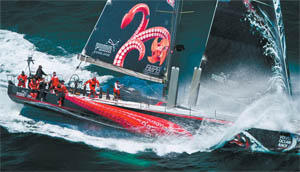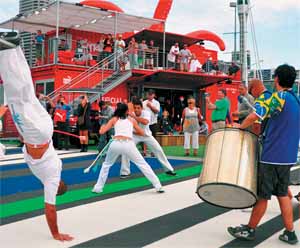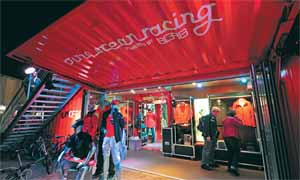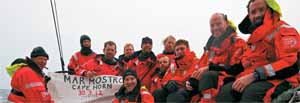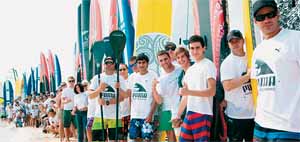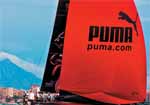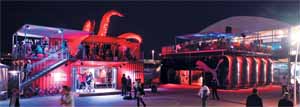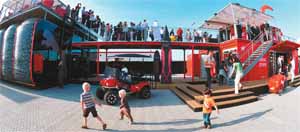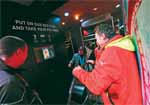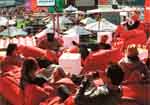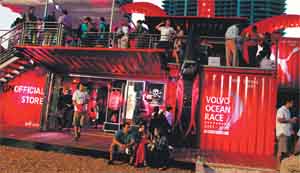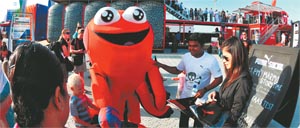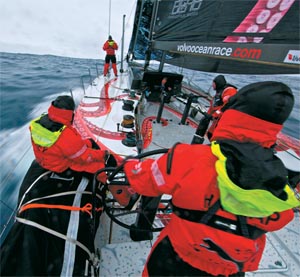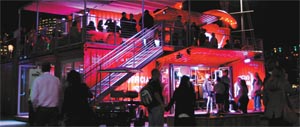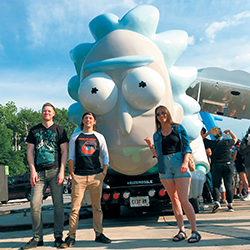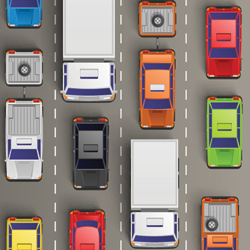| ROAD SHOW / MULTIVENUE |
Company: Puma SE
Event: Puma Event Retail for Puma Ocean Racing at the Volvo Ocean Race 2011 - 2012
Objectives: Create interest in the Puma brand among fashion-conscious consumers; drive retail sales of Puma shoes, clothes, and accessories; and increase brand awareness worldwide.
Strategy: Capitalize on Puma's participation in the Volvo Ocean Race with a mobile pop-up event space and retail store constructed at each of the race's 10 harbor visits.
Tactics: Use four branded, 40-foot shipping containers to create a retail space and lounge with an urban, industrial feel intended to appeal to Puma's trendy target market.
Results: Surpassed retail-sales goals for the entire event by 40 percent in the first three stops alone. Attracted hundreds of thousands of visitors.
Creative Agency: Kubik BV, www.thinkubik.com
Production Agencies: Bitmove BV, www.bitmove.nl; Blowups
Reklameobjecten BV, www.blowups.nl; Drei D Medien Service GmbH, www.dreid.com; Inflate Products Ltd., www.inflate.co.uk; Sino Peak Construction Machinery Co. Ltd.,
www.sino-peak.com.cn
Budget: $930,000 |
 uma SE, a Germany-based manufacturer of athletic
apparel and footwear, is not an unknown brand. In fact, thanks in large part to Brazilian legend Pelé, the Puma brand is synonymous with soccer the world over. Puma is to Pelé what Nike is to Michael Jordan. So why would the company, which reported revenues of more than $3.5 billion in 2010 and counts charismatic Usain Bolt (Olympic gold medalist, star of the Beijing summer games, and officially the fastest man alive leading up to the London games) as one of its sponsored athletes, feel the need to launch a global brand-awareness campaign in 2011? Simply put, it wanted to change out of its short shorts and running
shoes and slip into a pair of skintight "jeggings" and neon kicks. That's right - it wanted to chase the fashionista crowd. uma SE, a Germany-based manufacturer of athletic
apparel and footwear, is not an unknown brand. In fact, thanks in large part to Brazilian legend Pelé, the Puma brand is synonymous with soccer the world over. Puma is to Pelé what Nike is to Michael Jordan. So why would the company, which reported revenues of more than $3.5 billion in 2010 and counts charismatic Usain Bolt (Olympic gold medalist, star of the Beijing summer games, and officially the fastest man alive leading up to the London games) as one of its sponsored athletes, feel the need to launch a global brand-awareness campaign in 2011? Simply put, it wanted to change out of its short shorts and running
shoes and slip into a pair of skintight "jeggings" and neon kicks. That's right - it wanted to chase the fashionista crowd.
It's not so unbelievable that an athletic company would want to see its sneakers firmly on the feet of fashion-forward 20-somethings that dictate trends. In fact, Puma's archrival, Adidas AG, made a similar jump in the 1980s, courtesy of Run-D.M.C. The rap group brought their street style to the stage when they performed, and that style just happened to include the Adidas Superstar sneaker, which was originally designed as a basketball shoe. The group even wrote a song to express their admiration for their favorite kicks (in response to some haters in the rap world), and eventually penned an endorsement deal with the company.
Fast-forward 30 years, and the Adidas Superstar is still a go-to shoe among the fashion-conscious, hipster crowd, and has cemented itself as a fixture in pop-culture history. Understandably, Puma wanted a slice of that profitable pie. But it couldn't jump ship and change course completely - after all, it had legions of athletes loyal to Puma sports gear, and it didn't want to risk alienating them. Fortunately, there was an event on the horizon at which both athletes and consumers would convene in a perfect storm of marketing opportunities: The Volvo Ocean Race.
The biennial yacht race, which started in 1973 as the Whitbread Round the World Race until AB Volvo took over as the title sponsor in 2001, traverses the globe in less than a year. The 2011 - 2012 race would take sailers to Alicante,
Spain; Cape Town, South Africa; Abu Dhabi, United Arab Emirates; Sanya, China; Auckland, New Zealand; Itajaí, Brazil; Miami; Lisbon, Portugal; Lorient, France; and
Galway, Ireland. Not only does Puma have a team that races aboard the company's 70-foot Mar Mostro (aka "sea monster") vessel, that team came in second in the last Volvo Ocean Race, an accomplishment that cemented the importance of the race in Puma's overall marketing and brand-awareness efforts. "The Volvo Ocean Race is one of the world's iconic sporting events, and it proved to be an extremely successful marketing tool for us," says Jochen Zeitz, Puma AG chairman and CEO.
In addition to racing in the competition, Puma is also a title sponsor and has real estate in the event's
corresponding Race Village,
a mini city filled with corporate pavilions, restaurants, and shops that pop up on shore as the racers dock in each port for a few weeks' worth of concerts, performances, sailing clinics, and events. Thanks to the sheer popularity of the race, the success of Puma's sailing team, and the millions of people that visit the Race Village (it recorded a total of 4 million visitors among all stops during the 2008 - 2009 race), the company knew it had access to pieces that could bridge the gap between salted seafarers and casual consumers, and ultimately turn trendy youths into Puma enthusiasts. It just didn't know how to do it. For that, it enlisted the help of Kubik BV, the Amsterdam office of exhibit- and event-marketing firm Kubik Inc.
"Puma wanted to leverage its participation in the race
to drive sales of its sports clothing and heighten worldwide awareness of its lifestyle brand beyond the sailing crowd," says Hajo Reinders, managing director of Kubik BV. "We focused our efforts on creating a Race Village pavilion that would not only lure visitors, but would also provide a sales opportunity." And the key to accomplishing that, Kubik surmised, could be found in two pastimes favored among the young and trendy - shopping and chillaxing. Thus, the Puma pavilion would comprise a full-fledged retail store hawking the company's branded gear, and a lounge area perfect for hanging out and soaking up all things Puma.
Ship Shape
With the store and lounge idea percolating, Kubik sought design inspiration. The Puma pavilion - or Puma Quad, as it would be called - had to be eye catching, innovative, and bitching in order to attract the trendy youngsters the company was after. As luck would have it, Mar Mostro was all of those things. Conceived by London-based design firm GBH Design Ltd., the livery and graphics for the yacht comprised striking red, squid-like tentacles that wrapped around the boat's mostly black hull and part of the sail. In a nod to the Puma brand, the tentacles on the hull formed the company's signature swoosh found on all of its sneakers, and a graphic of a puma, dubbed the Aqua Cat, appeared to materialize from the sea and leap onto the bow. That same graphic was repeated in a much larger scale on the sail. All Reinders and his team at Kubik had to do was translate the boat's design into a retail space and lounge. Oh, and that retail space and lounge had to be portable, shippable, easy to install and dismantle, and durable enough to withstand nine months of harbor hopping.
Because of the nature of the event - a race across the world's oceans - commercial shipping containers, like the ones used to transport freight on trains and boats, seemed like a logical place to start. "The shipping-container concept met all the requirements of the race," Reinders says. "By using the shipping containers for the Puma Quad, we could create an easy-to-install, temporary setting. Plus, it would look pretty cool, too." What's more, all the materials, store
inventory, furniture, etc., that furnished the Puma Quad could simply be loaded up into the containers and shipped to the next port, a feature that impressed Corporate Event Awards judges, who called it "the epitome of efficiency."
Thus, Kubik's plans for the Puma Quad were simple enough, with the concept centered on four, 40-foot steel shipping containers painted in Puma's signature red color - the same red used for the tentacles painted on the Mar Mostro. And in fact, the tentacles would become a beacon atop the Puma Quad, as Kubik's design included three 16-foot-long, hallow, hard-polyester tentacles appearing to creep out of the shipping containers. A trio of the roughly 9.5-foot-tall containers would be placed on the ground and serve as supports for the fourth container, cantilevered on top like a wood block pulled halfway out of a Jenga tower. The four-container space would house the Puma retail store on the first floor, and a bar with a deck on the second floor.
To increase the effectiveness of the Puma Quad concept,
Kubik made two of them, so they could leap frog from port to port. "We knew the yachts would sail faster than our shipping vessels - it is a race, after all," Reinders says. "And having a backup ensured that the Puma Quad would make it to every port, where it would be installed and ready to go well before the racers and visitors arrived." So while one Puma Quad was being unloaded
and set up at the first Race Village in Alicante, Spain, for example, the
second Puma Quad would already
be on its way to the next port.
In addition to the Puma Quad, event plans called for a separate, 40-by-40-foot structure to house the Puma Social Club, an extension of another event-marketing concept launched in September 2010 to kick off the company's metamorphosis from athletic company
to lifestyle brand. The mobile club, which has its own microsite (www.puma.com/social), travels from city to city across the globe, setting up shop for a week at a time in brick-and-mortar venues located in or near hipster-laden areas. While open, the Puma Social Club hosts concerts and performances from local musicians and artists, and features everything from dances to ping-pong tournaments - activities that appeal to what the company refers to as "after-hours athletes."
Those after-hours athletes just happen to be the same trendy consumers Puma sought to attract during the Race Village, so the decision to pair the Puma Social Club with the Puma Quad was a no-brainer. To give the Puma Social Club a chic atmosphere that complemented the Puma Quad's industrial aesthetic, Puma turned to U.K.-based Inflate Products Ltd. "Puma wanted something big that could be packed down smaller than the shipping containers, and an inflatable structure met that requirement," says Inflate founder Nick Crosbie. But this wasn't anything like your kid's moon bounce.
Comprising a steel skeleton that served as a support system, the structure's inflatable elements came in the form of 8-foot-wide panels of black polyester PVC, chosen for its ability to deflect rain and dirt. The panels, which formed the sidewalls of the space, were covered in gray dots (the same dot texture that speckled the hull of the Mar Mostro) and inflated to create a bubble effect.
To juxtapose the soft, curvaceous sides, sleek, charcoal-gray glass comprised the front and rear façades, complete with double-wide glass doors to create a kind of semi-enclosed outdoor room. Adding to the outdoor enjoyment, an open-air deck, accessible by a staircase attached to the rear of the structure, covered the roof and featured a bar and seating areas. "We essentially designed a really cool place for people to hang out and chill," Crosbie says. And that's exactly what Puma wanted.
Calling All Landlubbers
With the design and construction underway for the Puma Quad and Puma Social Club, Puma turned to the next step: marketing. Fortunately, since the Volvo Ocean Race is essentially the Super Bowl of sailing, little needed to be done
by way of spreading the word about the event in general. What's more, Puma was a title sponsor, and its participation in the race was well publicized via press releases, the race's website www.VolvoOceanRace.com), and Puma's own event-specific microsite (www.puma.com/sailing), which featured blog posts, photos, videos, and updates from the Mar Mostro crew, as well as a calendar of Race Village events.
So in lieu of a big bucks, global, mass-media campaign promoting the Puma Quad in the weeks leading up to each port stop, Puma employed a combination of local billboards, print ads, and signage at its retail stores in the race's stopover cities. And to drive traffic to the microsite, Puma created a Mar Mostro-centered social-media presence via Facebook, Tumblr, Twitter, and YouTube, where the vessel's charismatic and humorous crew members posted video diaries, photos, blogs, and daily updates during the race. In addition, the company invited fashion bloggers in each port to visit the Puma Quad, hoping a glowing review would create some buzz and entice more trendy, young people to visit in subsequent cities as the store-slash-lounge made its way from port to port. So with the marketing machine plugging away and the Puma Quad and Puma Social Club ready to go, Puma was confident it would attract the fashion-forward consumers it eagerly sought. And with that, it packed up and set sail for the first Race Village stop.
When the Puma Quad and Puma Social Club landed in Alicante, the installation crew spent just five days setting it up before the Race Village festivities began on Oct. 14. As soon as the village opened its doors, visitors flooded the gates, eager to explore the shops, restaurants, pavilions, and activities inside. Much to Puma's delight, droves of landlubbers made a beeline for the hard-to-miss, 19-foot-tall Puma Quad, whose tentacles stretched upward, seemingly reaching out to grab curious passersby and pull them in. Once attendees succumbed to the lure of the strange structure (which resembled an "L" laying on its back when viewed from the side), they could enter through glass doors on either end of the bottom containers and shop in the roughly 13,000-square-foot retail space, filled with everything Puma from athletic apparel and shoes to fashion accessories and handbags.
After attendees perused the store's offerings, staffers invited them to participate in a sailing-inspired photo opportunity. Donning a crimson-red, Puma-branded sailing jacket, aspiring sailors took turns stepping in front of a backdrop that featured a graphic of red tentacles rising from the ocean. One by one, people took the "helm" of the Mar Mostro (a steering wheel mounted to the floor in front of the backdrop), and had their picture taken. The photos were then immediately uploaded to Puma's Facebook page and sailing microsite, and participants were encouraged to share the photos with friends and family.
As soon as the impromptu photo op was over, visitors headed back outside and trekked up a set of stairs leading to the Bar Mostro, housed in the fourth container. While upstairs, attendees perched on the roughly 750-square-foot wooden deck, enjoyed refreshing beverages and snacks, and took in the harbor sites and race activities happening nearby. And when they had their fill of sun, booze, and food, they made their way back down the stairs and headed across the courtyard to the Puma Social Club.
Here, Puma hosted a plethora of live events, ranging from educational classes for kids (part of the company's ongoing dedication to promote ocean preservation) and knot-tying lessons taught by Mar Mostro crew members to performances by local artists. Throughout the three-week run in Alicante, for example, the Puma Social Club played host to Spanish DJ Liz Mugler, Ibiza musician Sergio Gallegos, and the band Mision Amarte, among others.
In addition to concerts, the space hosted several Tapas Nights where attendees sampled various local culinary treats, and an opportunity to go on a run with Wilson Kipketer, a Puma-sponsored athlete and holder of nine world running titles. In between parties, concerts, and long-distance runs, attendees were encouraged to simply sit back and soak
up the Puma brand.
Wind in the Sails
The fact that attendees enjoyed hanging out in the Puma Quad and Puma Social Club is all well and good, but it also needed to lead to some cold, hard results in order to be considered a success by Puma. And it did. Exit polls for the Alicante Race Village showed that more than 70 percent of the estimated 940,000 visitors stopped by the Puma Quad and Puma Social Club - 40 percent above goal. In addition to surpassing its attendance objectives, Puma also exceeded its retail-sales goal by 20 percent. The positive results from Alicante proved that Puma had set a clear course for success.
By the time the Puma Quad and Puma Social Club landed in Abu Dhabi, the third stopover city, Puma's retail sales were already 40 percent above its target for the entire race. And when it hit the eighth stop, the store had recorded 17,000 transactions and sold 37,000 items, putting Puma well ahead of its sales goals. Needless to say, Puma was impressed by its performance. And so were judges, one of whom said, "The success of this event - which is entirely on brand, completely consistent, and really well executed - confirms that Puma has cachet beyond the sporting world."
By catering to the loyal fans of its sportswear and athletic shoes with the Puma Quad while introducing itself as a lifestyle brand to a whole new crop of consumers in the Puma Social Club, Puma successfully navigated the rebranding waters without losing speed. Now that's how you win a race. E
|




 uma SE, a Germany-based manufacturer of athletic
apparel and footwear, is not an unknown brand. In fact, thanks in large part to Brazilian legend Pelé, the Puma brand is synonymous with soccer the world over. Puma is to Pelé what Nike is to Michael Jordan. So why would the company, which reported revenues of more than $3.5 billion in 2010 and counts charismatic Usain Bolt (Olympic gold medalist, star of the Beijing summer games, and officially the fastest man alive leading up to the London games) as one of its sponsored athletes, feel the need to launch a global brand-awareness campaign in 2011? Simply put, it wanted to change out of its short shorts and running
shoes and slip into a pair of skintight "jeggings" and neon kicks. That's right - it wanted to chase the fashionista crowd.
uma SE, a Germany-based manufacturer of athletic
apparel and footwear, is not an unknown brand. In fact, thanks in large part to Brazilian legend Pelé, the Puma brand is synonymous with soccer the world over. Puma is to Pelé what Nike is to Michael Jordan. So why would the company, which reported revenues of more than $3.5 billion in 2010 and counts charismatic Usain Bolt (Olympic gold medalist, star of the Beijing summer games, and officially the fastest man alive leading up to the London games) as one of its sponsored athletes, feel the need to launch a global brand-awareness campaign in 2011? Simply put, it wanted to change out of its short shorts and running
shoes and slip into a pair of skintight "jeggings" and neon kicks. That's right - it wanted to chase the fashionista crowd. 